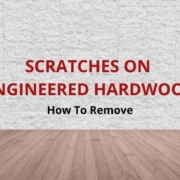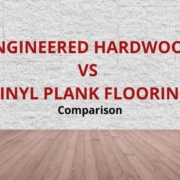Can You Install Engineered Wood Floors In A Bathroom?
Yes, engineered wood floors can be installed in a bathroom.
Engineered wood can also be installed in a basement and other places that solid wood can’t. Specifically, the kind of places that are prone to humidity and temperature changes.
Unlike solid wood, engineered wood floors stand up well to environmental changes. Bathroom and basement environments can change quickly, and this can happen routinely. But engineered wood is quite well suited to this.
Why Is Engineered Hardwood A Good Choice For These Kinds of Environments?
The layer of engineered wood that you can see is made of real wood. The core is made of layers of plywood. These are bonded together in such a way that they form a thick sort of mesh.
This core is what gives engineered wood floors the ability to withstand environmental changes. It’s what gives this type of floor more dimensional stability.
In other words, the core of an engineered wood floor won’t warp.
Can Engineered Wood Stand Up To Spills?
If your engineered wood floors were installed a few years ago, the answer is, “yes, but not for long”. Spills should be cleaned right away. Your floors should never be wet-mopped or allowed to air dry. This type of flooring is no less sensitive to standing water than solid wood is.
This has invariably been the case …until recently.
Recent Improvements in Engineered Wood Flooring Products
In the past few years, a lot has changed in the flooring industry.
Where having engineered wood flooring in bathrooms and kitchens was once thought to represent a lot of upkeep, manufacturers now claim that their newest improvements have made them trouble-proof and worry-free The biggest improvement — waterproofing.
Can You Let Engineered Wood Floors Get Wet?
Allowing your floors to get wet and allowing them to stay that way are two very different things. Water spills happen. Accidents are inevitable. But with traditional engineered wood, clean-up should take place as soon as possible.
This fact represents a bit of mindful care where bathrooms are concerned. In a bathroom where traditional engineered wood flooring is installed, everyone who uses it must be sure to leave no watery footprints behind. Everyone must be sure to clean up after themselves if they allow water to splash when washing their hands.
This makes traditional engineered wood a less-than-ideal choice for bathrooms that see a lot of use by youngsters.
The introduction of waterproofing is said to change all this. But does it?
In fact, the words, “waterproof” and “worry-free” should be synonymous. But are they?
Is Waterproof Engineered Wood Better For Bathroom Installations?
The very short answer is yes, although the rules change between brands and levels of water resistance.
Before deciding on a particular waterproof engineered wood floor product, it’s important to understand its capacity or level of water resistance.
Manufacturers of some engineered wood floors claim that a spill can safely go unseen or ignored for up to 12 hours on their improved variety. Others claim 24 hours, and some claim that their waterproof engineered wood can withstand a spill for up to 36 hours.
Right about now, you’re probably thinking that waterproof engineered wood floors can be installed in a kitchen. Well done! (pun intended)
Of course, once a cooking spill has been allowed to go unchecked for 24 to 36 hours, a new concern about how to clean up dried crud might be created.
…and naturally, taking care of this would involve the use of some type of liquid solution …and well, how the rest of this story goes seems to be anyone’s guess. But however it goes, waterproof is still better than not.
How Are Waterproof Engineered Wood Floors Different?
As discussed earlier, the difference is in the core. The core of traditional engineered wood is made of densely packed layers of plywood that give this type of floor more dimensional stability than solid hardwood.
Thus, engineered wood is better suited to below-grade installations and similar environments.
With waterproof engineered wood, the core is different from each manufacturer.
Some cores are made of stone plastic composite or SPC.
One manufacturer uses an “ultra-high-density fiberboard”.
Another manufacturer claims that their hardwood floor is waterproof as well as the most durable on the market. The floor is actually a laminate floor. How they get away with calling it “wood” isn’t clear.
Are The New Waterproof Engineered Wood Floors Better For Installation in Bathrooms?
Well, we do know that they’re at least somewhat more waterproof than the traditional kind of engineered wood floor. But this doesn’t necessarily mean they’re better.
Besides the fact that some manufacturers don’t seem to know or care that there’s a difference between waterproof and water-resistant, there are two cons.
- Waterproof floors can’t be refinished.
- Unlike traditional engineered wood, installing radiant heating underneath them is out of the question.
Waterproof or not, the fact that they can’t be warmed up might mean that no one will spend much time splashing about or letting their wet hair drip onto the floor.
So if you want to install engineered wood floors in your bathroom, you might as well stick with the traditional kind.
As long as you don’t install radiant heating, the floor isn’t as likely to be in prolonged contact with water anyway.
Engineered Wood Floors In Bathrooms: The Bottom Line
If you know you can successfully manage spills, install traditional engineered hardwood in your bathroom.
That way, you can install radiant heat while you’re at it.
As for the kids’/guest bathroom, it’s probably the smallest room in the house. If you’re going to experiment, this would be the place to do it.
Granted, engineered wood floors and children aren’t necessarily a match made in heaven. But you’ll probably be supervising their bath time anyway.
If not, then another adult. So, staying ahead of spills shouldn’t be a problem.
Teenagers might be a different story, but beyond this, there really isn’t much else to consider.
So go ahead — install engineered wood floors in the bathroom. Take care of them a little. Enjoy them a lot.
Table of Contents





